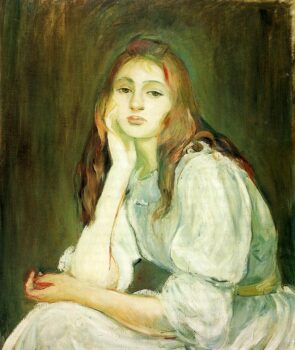The Meaning and Symbolism of “Julie Daydreaming”
Among the Impressionist artwork of the 19th century, few paintings resonate with the silent intimacy and emotive stillness of “Julie Daydreaming” by Berthe Morisot. Painted by one of the few prominent female figures of the Impressionist movement, this work encapsulates the grace, ambiguity, and complex emotional world of women, both as subjects and creators of art. Berthe Morisot’s tender portrayal of her daughter Julie is more than just a domestic portrait; it is a deep meditation on femininity, childhood, introspection, and the unspoken boundaries of societal roles.
This article will explore Julie Daydreaming through multiple lenses, its artistic style, symbolism, emotional resonance, and cultural significance, while shedding light on the artist herself and the context in which this painting was born.
Who Was Berthe Morisot?
Berthe Morisot (1841–1895) was a French painter and a central figure in the Impressionist movement. Alongside names like Claude Monet, Edgar Degas, and Pierre-Auguste Renoir, Morisot contributed significantly to the evolution of modern art. However, unlike her male counterparts, she had to navigate the constraints imposed on women in the 19th-century art world.
Morisot came from a well-to-do bourgeois family and received private art lessons as women were not allowed in formal academies like the École des Beaux-Arts. Her early work was influenced by Jean-Baptiste-Camille Corot, a leading figure in the Barbizon school, and she later developed her own Impressionist style characterized by light, fluid brushwork and an acute sensitivity to domestic life.
Unlike many male Impressionists who focused on urban landscapes and public life, Morisot’s world was often intimate and private, centering on the home, the garden, and women and children in everyday scenes. This focus wasn’t a limitation; rather, it was her unique strength and voice in the Impressionist canon.
Painting “Julie Daydreaming”: Context and Creation
“Julie Daydreaming” (French: Julie rêvant), painted in 1894, is one of the many portraits Morisot created of her daughter, Julie Manet. Julie was not just a subject but also a muse and a symbol of continuity in Morisot’s artistic journey. Morisot painted Julie in various stages of her childhood and adolescence, capturing her moods, her silences, her joys, and her dreams.
By 1894, Morisot was in the final year of her life. She had been recently widowed, her husband Eugène Manet, the brother of painter Édouard Manet, died in 1892. The emotional tone of Julie Daydreaming is thus colored by both maternal affection and the weight of grief, reflection, and the passing of time.
Julie is depicted in a moment of reverie, seated, perhaps leaning against a surface, her face turned slightly away, her gaze unfocused and drifting beyond the frame. There’s no direct interaction with the viewer; we are observers of a private moment. The brushwork is soft and delicate, suffused with the silvery light and gentle pastels typical of Morisot’s late style.
What Is Happening in “Julie Daydreaming”?
On the surface, very little appears to be “happening.” Julie is not engaged in any action; she is not reading, sewing, or speaking. She is simply thinking. This moment of stillness is, paradoxically, rich with inner motion.
What makes Julie Daydreaming powerful is precisely this lack of overt action. It’s a visual poem about solitude, imagination, and interiority. Morisot captures her daughter suspended between childhood and adolescence, reality and fantasy. The dreamy expression on Julie’s face suggests a world beyond the canvas, a mental space that we, as viewers, are invited to imagine but can never fully enter.
What is the Meaning of “Julie Daydreaming” Painting
The painting is a tapestry of meanings, both personal and universal.
1. Feminine Interior Life
Morisot’s work consistently foregrounds the emotional and psychological worlds of women and girls. In an era when women were rarely afforded such complex representations, Julie Daydreaming presents a young girl not as a passive decorative figure, but as a thinking, feeling, interior subject. Her reverie is her own; it is not for display or performance.
This subtle assertion of female autonomy, within the private sphere, is one of Morisot’s most profound contributions to modern art.
2. Maternal Gaze
As a mother painting her daughter, Morisot presents a rare example of what could be called the “maternal gaze” in art. Most female subjects in art history were painted by men, often through the lens of desire, idealization, or moral instruction. Morisot’s gaze is neither objectifying nor moralizing. It is tender, observant, and infused with love.
Julie’s pose and expression reflect both distance and connection, she is her own person, yet still very much Morisot’s child. This duality enriches the emotional complexity of the work.
3. The Symbolism of Daydreaming
Daydreaming symbolizes imagination, freedom, and the latent power of the unconscious. It is an escape, a refuge, and a space of possibility. In Julie Daydreaming, the act of dreaming becomes an assertion of the girl’s inner life, a world inaccessible to external control.
In the context of 19th-century gender norms, where girls were often groomed to become compliant women, Julie’s daydreaming could even be read as a quiet rebellion, an inward turn away from societal expectations.
Impressionist Style and Artistic Techniques
Julie Daydreaming is quintessentially Impressionist in technique but intimate in focus.
Brushwork and Light
Morisot’s brushwork is airy, almost ethereal. The loose strokes convey the fleeting quality of light and mood, central tenets of Impressionist painting. The light does not dramatically illuminate the scene; rather, it bathes it in a gentle softness, enhancing the introspective tone.
Color Palette
The color palette is muted, delicate, and dominated by whites, lavenders, blues, and soft pinks. These tones evoke tranquility, innocence, and melancholy, perfectly aligning with the theme of daydreaming and adolescence.
Composition
The composition is informal, asymmetrical, and cropped in a way that suggests a spontaneous snapshot rather than a staged portrait. This style, influenced by photography and Japanese prints, was revolutionary for its time and a hallmark of Impressionism.
How Does “Julie Daydreaming” Fit Into Morisot’s Oeuvre?
Morisot painted Julie more than any other subject in her career. From infancy through adolescence, Julie was a living canvas of Morisot’s evolving technique, emotions, and vision. Julie Daydreaming is among the most poignant of these portraits, as it captures not only the personality of her daughter but also Morisot’s own growing awareness of time and mortality.
In many ways, the painting feels like a goodbye, a mother documenting one last moment of serenity before the inevitable tide of adulthood, independence, and loss.
What Kind of Art Is “Julie Daydreaming”?
Categorically, Julie Daydreaming is an Impressionist portrait, but it also blends elements of intimism, a late 19th-century movement focused on quiet domestic interiors and personal themes. While it shares the brushwork and light of Impressionism, its subject matter is more private, emotional, and contemplative than the bustling outdoor scenes favored by artists like Monet or Pissarro.
It is also an early precursor to psychological portraiture, a genre that would flourish in the 20th century with artists like Edvard Munch and Egon Schiele. Morisot, in her quiet way, anticipated these deeper explorations of the human psyche.
Where Is “Julie Daydreaming” Today?
Julie Daydreaming is part of the Musée Marmottan Monet collection in Paris, France. The museum houses the world’s largest collection of works by Berthe Morisot, including numerous portraits of Julie, as well as works by other major Impressionists like Claude Monet and Edgar Degas.
The museum provides not just a visual experience but a historical context for understanding Morisot’s life, struggles, and achievements. Viewing Julie Daydreaming in this setting allows one to fully grasp its importance within the broader arc of Impressionism and feminist art history.
Value and Market Estimate
While Julie Daydreaming is not currently for sale and resides in a public museum, its value is immense, both artistically and financially. Berthe Morisot’s works have seen significant appreciation in the art market over the past few decades. In 2013, her painting Après le déjeuner sold at Sotheby’s for over $10.9 million, setting a record for her work at the time.
Given its subject matter, artistic quality, and historical significance, Julie Daydreaming would likely fetch $15–20 million or more if it were to appear at auction, though its cultural value is arguably beyond price.
Julie Daydreaming Legacy and Influence
Julie Daydreaming represents a fusion of personal and artistic legacy. Julie Manet would later become an artist and writer herself, preserving her mother’s memory and contributing to the historiography of Impressionism. Through this painting, and others like it, Morisot not only immortalized her daughter but also etched her own name into the story of modern art.
Today, Berthe Morisot is increasingly recognized as one of the most innovative and emotionally resonant artists of her time. Her ability to convey psychological depth, particularly in women and children, has made her a reference point for contemporary female artists exploring similar themes.
“Julie Daydreaming” by Berthe Morisot is more than a mother’s portrait of her daughter; it is a profound meditation on identity, femininity, and the beauty of private thought. Through soft brushstrokes and a luminous palette, Morisot captured not just a fleeting moment, but an entire emotional universe.
In an art world that often marginalized women, Morisot painted her truth, honestly, delicately, and insistently. And in Julie’s faraway gaze, we glimpse not just a girl dreaming, but an artist reflecting, a mother hoping, and a woman remembering.
This quiet masterpiece continues to speak across the centuries, reminding us that stillness can be powerful, that daydreams can be revolutionary, and that love, when expressed through art, never fades.




